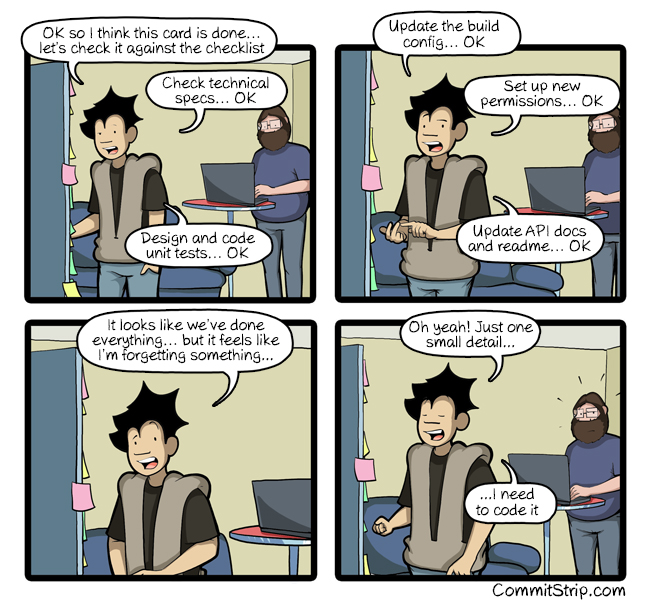About three years ago I wrote up some of my thinking on what you need to succeed in remote work and I still stand by most of that advice. But right now many of those suggestions may need to be goals you are working towards.
A few days ago my friend Johanna, who like me routinely works from home, learned she’ll be working from home while she and her partner try their hand at homeschooling and offered this tweet:
She’s both absolutely right (and smart, so if you’re on Twitter you should follow her), but also a little wrong. This is not what work from home normally is like, but this is what work from home is like in this moment.
Right now a huge number of people are suddenly working remote for the first time. Some of you probably wanted to this for a long time and are suddenly getting the chance, and some didn’t really want a remote job but now are forced to try it.
While some companies already have the tools and habits in place to make remote work successful, most probably don’t. What’s more, many people are now also doing childcare/homeschooling at the same time. So let’s be clear this is a terrible way to start working remotely. But here we are, so let’s talk about ways to use enough duct tape to make it work.
Your Boss
Lots of people probably have bosses that are deeply uncomfortable with this whole thing. They may have fought allowing remote work for long time because they worry about monitoring remote work and have no experience with remote management–those fears are likely still there and will put them off their game. Managers who are uncertain about basic working conditions can make bad choices that make a bad situation worse – like trying to monitor everyone on video conference all day. I’ve worked remote for bosses that didn’t trust me if they couldn’t see me, it’s hard and makes it hard to be successful. Long-term if they don’t learn to adjust you should probably find someone better to work for, but in the short run that’s probably not an option (and hopefully they will adjust) so let’s talk about strategies you can use to get through.
Check in early in the day so they know you’re up and running.
This should be something informal like a quick email to verify a meeting or other detail, a chat message just greeting them warmly, or something similar. Basically give them a sense that you are around and active before they ping you to find out if you remembered to wake up. You don’t want to sound needy or like you’re asking their permission to do work, as that can encourage micromanagement instincts.
Check in again at the end of the day, letting them know you’re leaving.
Again this should be something informal and simple that gives them, and you, a sense of closure to your work day. This helps avoid them feeling like you just disappeared while they adjust to the routine.
Leave a documented work trail with timestamps.
Think emails, notes from meetings, hours tracking and billing systems, Word documents with update timestamps, version control systems, and other things that you can point to that will remind them you really were working even though they didn’t see you (and if things get ugly something you can show others to prove you were working).
Start early or work late a few times early on.
Again this is about helping them see that you really are working hard even though they can’t see you. You still need to maintain work/life balance so don’t do this every day, or even most days, just enough that they are able to notice the effort in a crisis.
Suggest new or better tools to help support the sudden remote culture.
They probably know things aren’t working super well, and a chance to blame tools may be welcome. So research and suggest tools that make things better. Try to spot the things that have them uneasy about the situation and offer tools that might help with those challenges.
Your Tools
On the topic of tools, if your team just went fully remote you probably are lacking some tools to do all the things a great remote team has in place. You aren’t going to fix that overnight, but don’t let the perfect be the enemy of the good here – a tool that your team uses is better than the perfect tool that no one adopts.
So if you need to pick a chat client try the low hanging fruit first. You’re a Microsoft shop with 365 setup? Use Teams. You a Google apps shop? Use Hangouts. Salesforce? Chatter. Use Zoom a lot? Well their chat is terrible so use Slack (everyone else should probably default to Slack too). Some of those tools are far better than others but each has a niche they serve very well, and maybe your team will switch one day but get started now and worry about using it really well later.
Your Family
Don’t sweat the kids and pets interrupting. My current team was nearly 100% remote before all this started. We’re professional, have a strong team work ethic, and work hard to make sure our clients see that. And you know what, people’s kids and pets get in the way sometimes. Rarely does it matter for more than a minute or two. Right now, we’re running into a lot more of that than is normal. So are our clients. It’s going to be just fine.
Normally we try to limit interruptions, but honestly pets and kids are welcome cute distraction more often than not. My dogs wander my office and often end up on camera. My boss’s cat frequently strolls across his desk during check ins. Other people’s children come in and wave to all the people on their parent’s computer screen. Sure there are times we need to focus and someone’s dog really really needs to bark at that cat outside the window. Or a child needs their parent’s attention the very minute we’re trying to solve a hard problem. It’s just part of how things flow, and within my team we understand it as a part of work from home since it gives us all more time with the people that matter most to us all (hint: not our colleagues). Family, in whatever form they come, are part of what makes us who we are and allows us to see each other as a more complete person.
Yes, in this moment when kids are suddenly off from school with few places having formed any reasonable plan for education continuity, even for experienced teams we are expecting it will be disruptive. The entire American workforce is going to have to learn to deal with either their kids, or their colleagues kids, suddenly being around. Do your best to maintain focus and professionalism, but expect cracks, and let those imperfections help you get to know your colleagues better.
The next few weeks or months will be a lot of remote work duct taping even for experienced teams. You, your team, and your families, will learn to get better at this over time. Embrace that you’re learning, expect mistakes, and just plain do the best you can at the moment.






